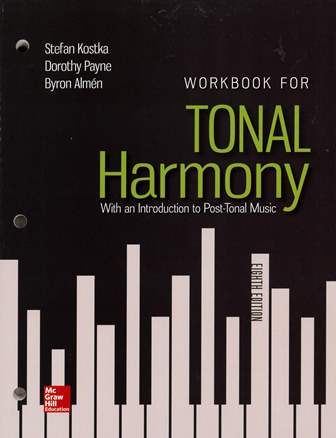書籍分類

(E-Book) Workbook for Tonal Harmony: With an Introduction to Post-Tonal Music 8/e
作者:Stefan Kostka, Dorothy Payne, Byron Almén
原價:NT$ 1,000
ISBN:9781260179255
版次:8
年份:2018
出版商:McGraw-Hill
頁數/規格:電子書
版次:8
年份:2018
出版商:McGraw-Hill
頁數/規格:電子書
內容介紹 本書特色 目錄
- 電子書訂購前請先詳讀:
- 訂購付款完畢後,請填寫 電子書回報資料-官網訂單,資料若不全,將影響您後續派送權益
- 查看 電子書平台登錄與註冊說明
- 查看 電子書平台操作手冊
- 此訂單為電子書,非紙本課本,電子書兌換碼一旦派送,則無法辦理退貨。
- 若有任何問題請 Email 至 ebook@tunghua.com.tw
- A student workbook (available in print and digital format.) All audio excerpts needed to complete the exercises are embedded in the eBook workbook.
- Connect® with SmartBook™ adaptive reading experience.
- Embedded audio, in the SmartBook, featuring recordings of every example from music literature found in the text, performed using the same instrumentation seen in the examples.
- Interactive drills embedded in the Smartbook, which offer students a wealth of hands-on practice as they read.
帳號訂購流程
Step 1 登入會員 非東華網站會員,請點選右上角『註冊』。
Step 2 點選 『加入購買』填寫相關資料,並確認訂單無誤後,即可送出訂單。
Step 3 審核訂單 訂購單會盡力於24小時內(遇周末假日順延)審核,確定有庫存,系統會發送『付款通知信』至指定信箱。
Step 4 付款 收到付款通知信後,請於七天內付款。
Step 5 電子書兌換碼 確認入帳後,約 1-3 個工作天派送電子書兌換碼,會發訊息至您的個人 email 信箱。
Description
Grade Levels: 9-12
Leading Text, Straightforward Approach to AP Music Theory
For more than two decades Tonal Harmony has been the leading text for AP Music Theory students and music majors. Used at nearly 800 schools, Tonal Harmony has been consistently praised for its practicality and ease of use for student and teacher alike. The straightforward approach is supported by well-chosen examples and thoughtful exercises, and the total presentation is compatible with differing teaching styles and theoretical points of view.
This edition also includes:







